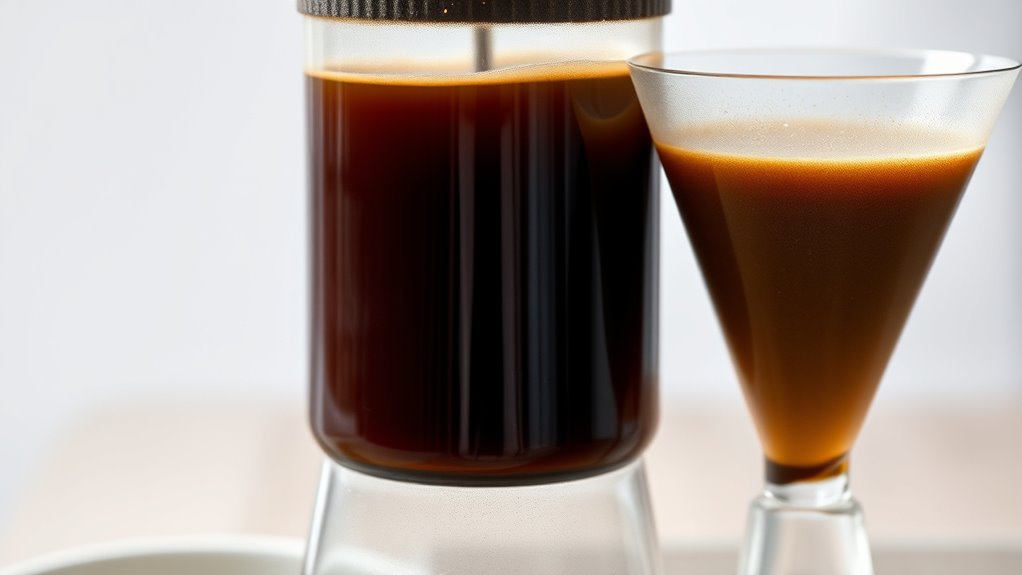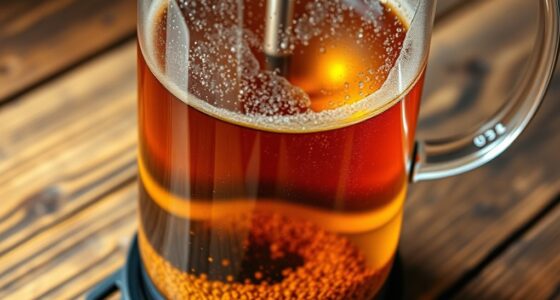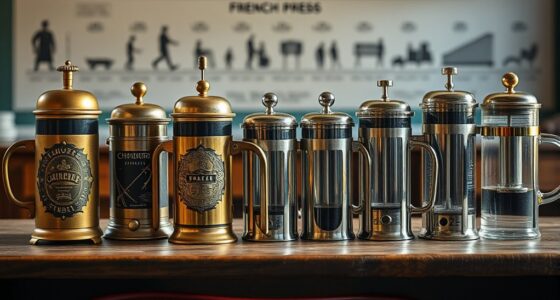If you prefer a full-bodied, rich coffee with a velvety mouthfeel, the French press is your best choice, as it retains oils and solids for a heavier texture. For a smoother cup with cleaner clarity and less sediment, the Aeropress offers a balanced body with more control. If you seek bright, nuanced flavors with maximum clarity, the pour-over emphasizes brightness and clarity. To explore how these differences shape your perfect cup, keep exploring further.
Key Takeaways
- French press produces a full-bodied, rich cup with more oils and sediment for a velvety mouthfeel.
- Aeropress yields a smooth, full-bodied brew with cleaner clarity due to paper filtration.
- Pour-over emphasizes clarity and brightness, resulting in a lighter, more nuanced cup.
- French press’s longer steeping time enhances body but increases sediment in the cup.
- Aeropress and pour-over offer clearer, sediment-free coffee with less body compared to French press.

When it comes to brewing coffee at home, choosing the right method can make a big difference in flavor and convenience. If you’re aiming for a specific balance of body and clarity, understanding how each brewing method influences these qualities is essential. The French press tends to produce a rich, full-bodied cup with a velvety mouthfeel, thanks to its immersion brewing process that extracts oils and solids thoroughly. This method generally has a longer brew time, usually around four minutes, which allows for maximum extraction of flavors and body. The result is a coffee with a robust, heavy body that’s perfect if you enjoy a strong, satisfying cup. However, the French press can be a bit more involved when it comes to cleanup. The metal or plastic plunger and mesh filter require rinsing and occasionally scrubbing to remove oils and coffee grounds, especially if you brew frequently. While it might take a few extra minutes, many find the rich flavor payoff worth the effort. Additionally, the French press’s use of natural materials like glass and metal enhances its rustic appeal and durability.
In contrast, the Aeropress offers a more versatile brewing experience with a surprisingly quick brew time—often under two minutes. Its compact design and pressure-based extraction allow you to control both body and clarity more precisely. When you press the plunger, you can produce a cup that’s smooth and full-bodied, but with a cleaner, brighter clarity compared to the French press. The Aeropress’s paper filters trap most of the oils and fines, leading to a cleaner cup with less sediment. Cleanup is straightforward: disassemble the parts, rinse, and discard the used coffee grounds. The process takes just moments, making it ideal for quick mornings or when you want minimal fuss. Plus, because you can easily adjust parameters like grind size and brew time, you can tailor your coffee’s body and clarity to your preference. Its portability also makes it suitable for outdoor use or travel.
Pour-over brewing emphasizes clarity over body, with a shorter extraction process that highlights the coffee’s brightness and nuanced flavors. The brew time usually falls between two and three minutes, depending on your pouring technique and grind size. The paper filters used in pour-over methods catch most oils and fines, resulting in a cup that’s clean, crisp, and vibrant with clarity. It’s a method that allows you to see and control the flow of water, giving you precision over extraction. Cleanup for pour-over is minimal—just discard the used paper filter and rinse the dripper. Since there are no internal parts to scrub or soak, it’s quick and easy, making it perfect for those who appreciate a bright, clear cup without the hassle of extensive cleanup. The simplicity of the pour-over setup also complements the farmhouse aesthetic, adding a touch of rustic charm to your brewing ritual.
Each method offers a unique balance of body and clarity, influenced by brew time and cleanup process. Your choice depends on your preferences for richness, brightness, and convenience, but understanding these factors helps you craft the perfect cup every time.
Frequently Asked Questions
How Does Grind Size Affect Each Brewing Method’s Flavor?
Your grind size directly impacts each brewing method’s flavor by influencing extraction balance. For French Press, a coarse grind prevents over-extraction and yields a full-bodied, rich flavor. In Aeropress, a medium grind offers a balanced extraction, allowing clarity and body to shine. For pour-over, a fine grind enhances clarity but risks over-extraction if too fine. Adjusting grind size helps you control flavor and achieve your preferred balance.
Which Method Produces the Most Consistent Results?
Like a well-oiled machine, the AeroPress delivers the most consistent results. Its design allows you to control grind size consistency and brewing temperature precisely, leading to reliable brews every time. You’re less likely to encounter variability with AeroPress, unlike French Press or pour-over, which are more sensitive to inconsistent grind sizes and temperature fluctuations. For steady, predictable results, AeroPress is your best bet.
How Does Brew Time Impact Clarity and Body?
Brew time directly impacts flavor extraction, affecting both clarity and body. If you extend brew time, you’ll extract more oils and solids, creating a fuller body but potentially muddying clarity. Shorter brew times improve clarity by limiting extraction, resulting in a brighter, cleaner cup. Adjusting brew time lets you balance body and clarity to match your preference, so experiment to find the ideal duration for your desired flavor profile.
Are Certain Beans Better Suited for Specific Methods?
Think of beans as musical instruments, each with a unique voice suited for certain settings. Light roasts with bright, acidic notes shine in pour-over, highlighting clarity. Medium roasts balance body and flavor, great for Aeropress, while dark roasts, rich and bold, excel in French Press. Selecting beans with matching flavor profiles and roasting levels guarantees your brewing method enhances their natural qualities, creating a harmonious cup.
What Are the Maintenance Differences Among These Brewing Devices?
You’ll find cleaning routines vary: French presses need regular disassembly and thorough washing to prevent oil buildup, while Aeropresses are quick to clean with a rinse, making maintenance simple. Pour-over equipment requires occasional cleaning of the dripper and filter holder. Durability comparison shows French presses are often sturdy but fragile if dropped, Aeropresses are durable and portable, and pour-over gear lasts long with proper care. Regular cleaning keeps each device performing well.
Conclusion
Ultimately, choosing your perfect brew boils down to balancing body and clarity. French press offers a full, flavorful feast, while AeroPress delivers a smooth, swift sip. Pour-over provides pristine purity with precise precision. Decide based on your desire for depth, detail, and dynamism. Whether you crave richness, refinement, or rapid results, mastering these methods means maximizing every mug’s magic. Make your morning memorable with the marvelous, mindful mix that matches your mood and method.









